Bagh-e Sangi | Iran’s Unique Stone Garden in Sirjan
Bagh-e Sangi in Sirjan stands out as a unique site, featuring an intriguing display of stones suspended from the branches of withered trees.
Sirjan, a city in Iran’s Kerman Province, is situated in a region known for its vast desert landscapes and rich cultural history. Located in a naturally arid area, Sirjan is characterized by rugged terrain, resilient plant life, and a long-standing tradition of craftsmanship and agriculture. Historically, it has been a hub for trade, thanks to its strategic position on ancient routes that connected various parts of Iran. Today, Sirjan is not only known for its traditional handicrafts, such as handmade kilims and carpets, but also for one of its most unusual attractions—the Stone Garden, or Bagh-E Sangi.
The Stone Garden in Sirjan is a one-of-a-kind site, known for its remarkable arrangement of stones hanging from the branches of dried-out trees. Unlike typical gardens with greenery and blooming flowers, this garden presents a display of stones, each tied to tree limbs and arranged purposefully. This unusual garden reflects an intense personal vision.
Bagh-E Sangi is more than a visual curiosity; it reflects the creator’s resilience and unique perspective. Unlike traditional gardens, which are associated with life and growth, this garden expresses loss, transformation, and endurance.
Background of Bagh-E Sangi
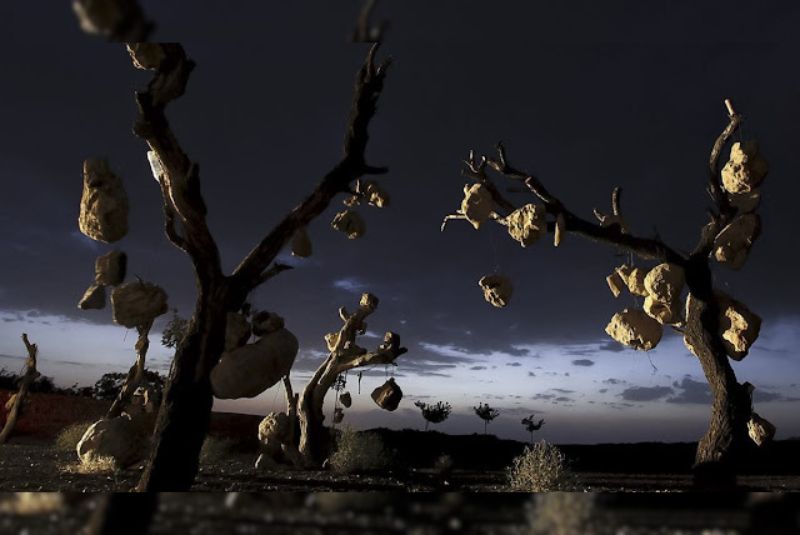
The origins of Bagh-E Sangi trace back to a defining moment in the life of Darvish Khan Esfandiarpour. Esfandiarpour, once a farmer in Sirjan, suffered a profound loss when he was forced to give up his agricultural land. This hardship drove him to create something meaningful on the remaining plot of his land, a place that could capture his emotions and embody his connection to the land. Esfandiarpour began to collect stones from the surrounding area, each carefully chosen, and attached them to the dried branches of trees scattered across his barren land. The garden became a space where he could share his story and emotions without words.

The Stony Garden is made up of numerous trees, each holding stones of various sizes, shapes, and colors that are attached to their branches by wires. Rather than following a uniform arrangement, each tree displays a different collection, allowing visitors to interpret each piece individually. The visual effect is striking—stones hanging where one might expect to see leaves or fruit, turning the garden into an almost sculptural space. The silence of the desert, combined with the unusual placement of the stones, conveys a deep sense of solitude and reflection. Esfandiarpour’s choice of stones reflects his personal struggles, perhaps symbolizing the weight of hardship and loss, yet they also show how he adapted to his changing world through creativity.
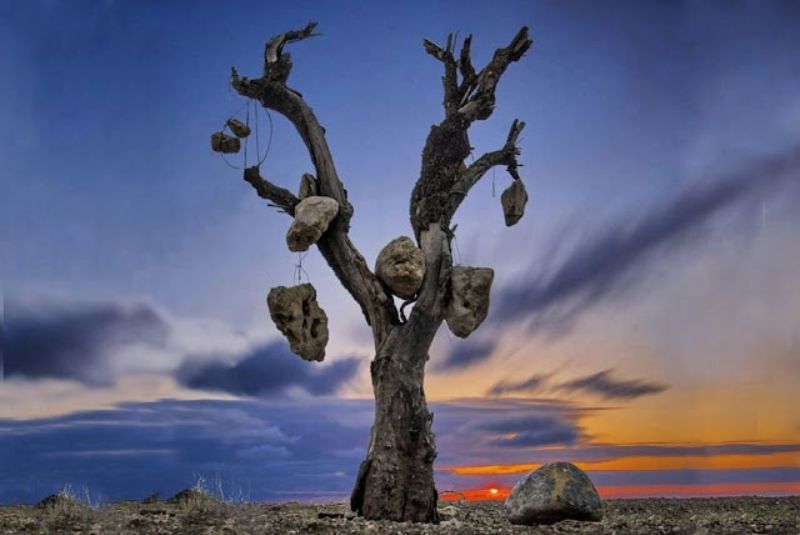
Bagh-E Sangi has become a reflection of the strength and adaptability of the local community. In the harsh conditions of Sirjan’s landscape, where survival is often a challenge, the garden stands as a reminder of the people’s determination to endure. The garden is appreciated both by locals and visitors who recognize its significance as an artistic and cultural site. For travelers, it offers insight into the relationship between humans and their environment in this part of Iran, illustrating how art can become a means of expressing resilience and preserving memories, even within the simplest of materials
Mystic Landscape of Stone Garden

Bagh-E Sangi unfolds across a modest expanse of arid land, with rows of dried, leafless trees that stretch against the open desert sky. Each tree stands tall and bare, rooted in the parched soil, and is adorned with stones of varying sizes. The stones are suspended from the branches with metal wires, creating a sparse yet visually compelling arrangement. The dry, almost skeletal trees create an unexpected contrast with the dense, weighty stones they bear, drawing the eye to each individual detail within the landscape. This layout allows visitors to walk between the trees, examining each piece closely while feeling a sense of solitude within the vast, open desert surrounding the garden.
Artistic Elements

The arrangement of stones on each tree in Bagh-E Sangi is a captivating display of balance and subtle artistry. Stones are selected and suspended with attention to their shape, size, and color, with no two trees arranged identically. Some stones are smooth and rounded, while others have rugged edges and irregular forms.
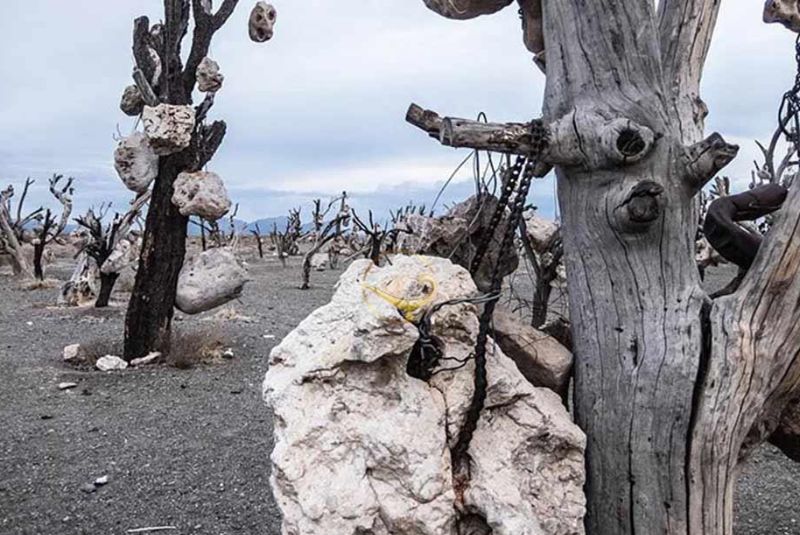
The way they hang from the branches creates a silent, contemplative atmosphere, as if each stone is holding its own story. The methodical arrangement encourages visitors to stop and observe the interplay of stone and tree, contrasting the hard, solid rock with the stark, brittle branches. The garden as a whole presents an unusual yet harmonious balance between nature and human creation.
Symbolism of the Stones and Trees

Each tree in Bagh-E Sangi, stripped of its leaves and life, can be seen as a symbol of resilience amid difficult conditions. The barren branches reflect the challenges of the desert environment and may even represent the hardships faced by the garden’s creator, Darvish Khan Esfandiarpour, in his life. The stones, on the other hand, could signify endurance, their weight symbolizing burdens carried over time. Together, the trees and stones reflect themes of loss, survival, and transformation, offering a raw interpretation of the strength required to adapt to change while remaining rooted in one’s land.
Visitor Experience

Walking through Bagh-E Sangi, visitors are met with a quiet, almost solemn ambiance. The lack of greenery and the unusual display of stones create a sense of stillness, amplifying the vastness of the desert surroundings. As visitors approach each tree, they can take time to examine the details up close—seeing how the wires are carefully wrapped around each branch and noticing the individual characteristics of each stone. The silence and simplicity of the garden invite a reflective experience, encouraging visitors to slow down and appreciate the rawness of the setting. The simplicity and the symbolism of the garden evoke feelings of respect for the creativity and endurance reflected in the site.
The Stony Garden Location and Accessibility
Bagh-E Sangi is located near the city of Sirjan, in Kerman Province. Visitors traveling from Kerman can reach Sirjan by road, approximately a two-hour drive covering around 175 kilometers. From Sirjan’s city center, the garden is located to the south and can be accessed by local transportation or rental car. For those coming from farther cities, Sirjan can also be reached from Yazd (a roughly three-hour drive) or Bandar Abbas (about 250 kilometers to the south).
Best Time to Visit
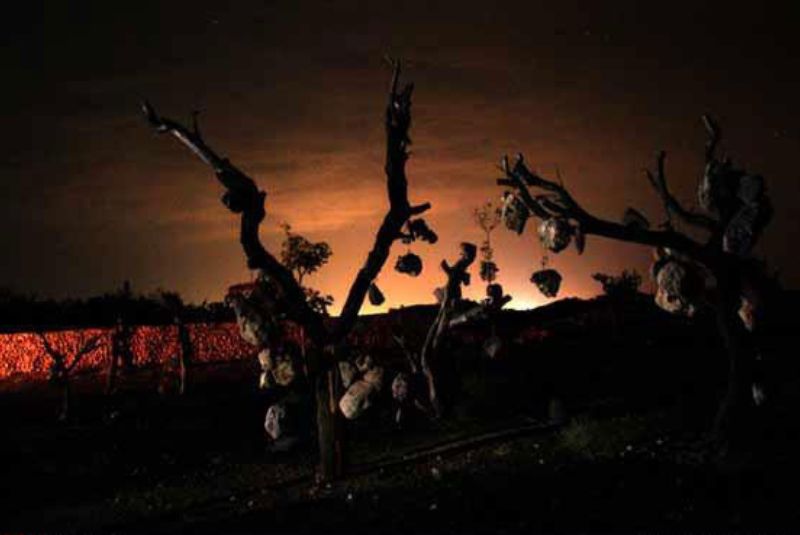
The optimal times to visit are during Iran’s cooler months, particularly in early spring (March to May) or autumn (October to November), when the temperatures are mild. Summers in the desert can be very hot, making daytime visits challenging, while winter can bring chilly evenings.
Visiting Hours and Entrance Fees

Although Bagh-E Sangi is accessible year-round, the best visiting hours are early morning or late afternoon, allowing visitors to enjoy cooler temperatures and softer sunlight for photography. Entrance to the garden is typically free, though travelers are encouraged to confirm this with local information sources, as changes to entry policies may occur.
Tips for Travelers

For visitors interested in photography, early morning or late afternoon provides the best natural lighting, creating contrast with the stones and casting long shadows that enhance the depth and mood of the garden. Taking close-up shots of individual stones and branches can also capture the details that make this site so visually unique.
Since the garden is located in a remote desert area, it’s essential to come prepared:
- Carry plenty of drinking water to stay hydrated, as there are limited facilities nearby.
- Sunscreen, a hat, and sunglasses are recommended to shield from the strong desert sun.
- The terrain around the garden can be uneven, so wear sturdy footwear to ensure a comfortable experience.
Nearby Attractions in Sirjan
Sirjan Salt Lake (Daryache Namak)
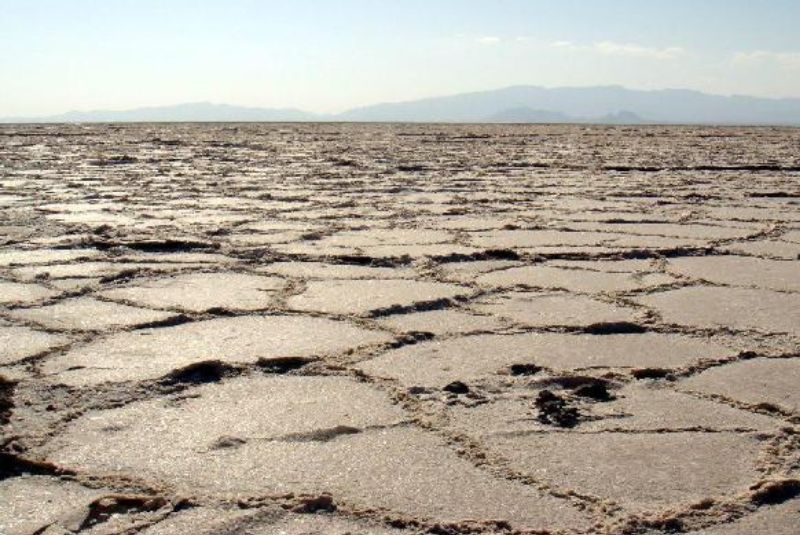
Just outside Sirjan, the Sirjan Salt Lake offers visitors an expansive salt flat with striking natural beauty. During certain times of the year, the lake’s surface crystallizes, creating unique salt formations and mirror-like reflections, especially under the evening or morning sun. For photography enthusiasts, the lake presents incredible opportunities to capture this otherworldly landscape, with its intricate patterns and stark white terrain against the backdrop of the desert.
Kerman’s Historic Bazaar
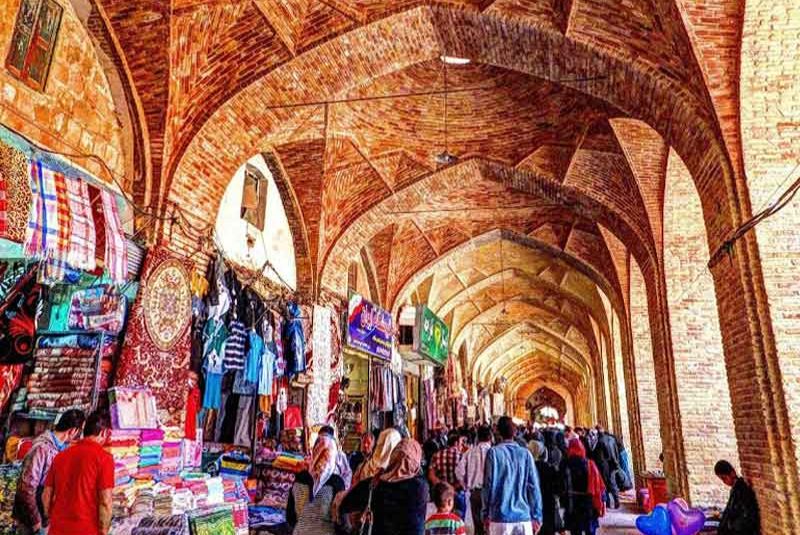
About an hour’s drive from Sirjan, Kerman’s bazaar is a lively and historic spot where visitors can experience traditional Iranian markets. Known for its handicrafts, textiles, spices, and copperware, the bazaar offers an authentic atmosphere and a variety of goods that showcase local craftsmanship. Visitors can also explore the intricate traditional architecture within the bazaar, adding to the cultural richness of the experience. This market is ideal for picking up unique souvenirs or simply enjoying the vibrant local ambiance.
Shahzadeh Mahan Garden (Bagh-e Shahzadeh)
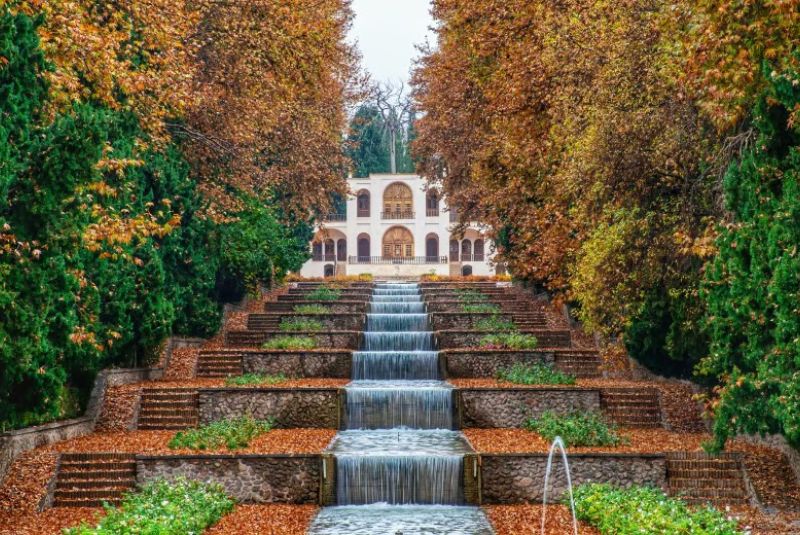
Located in Mahan, this garden is a beautiful example of a traditional Persian garden with its flowing water channels, lush greenery, and elegant buildings. Set against the arid mountains, the Shahzadeh Mahan Garden combines well-maintained plant life with classic Persian architecture. Its symmetry and tranquil water features make it a refreshing spot and a wonderful contrast to the more rugged atmosphere of the Stone Garden. This site provides a relaxing environment for visitors to enjoy a traditional Persian landscape design.
Rayen Castle (Arg-e Rayen)
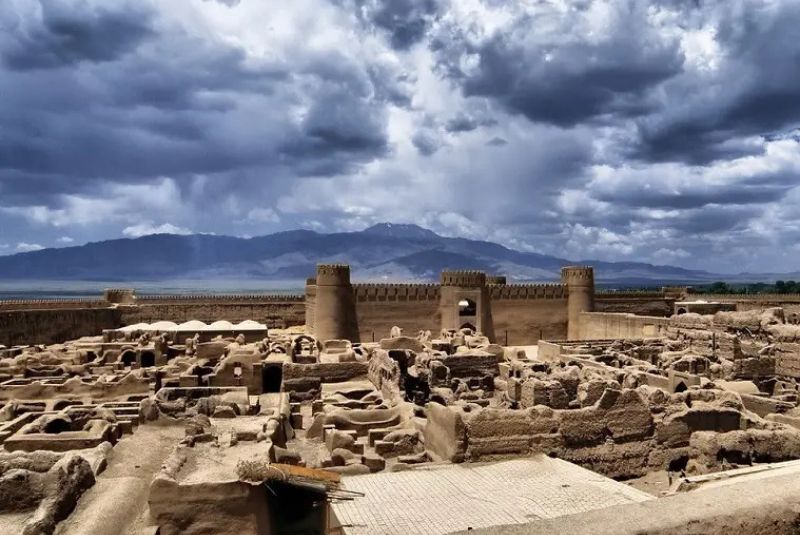
Rayen Castle, located in Rayen and within easy reach of Sirjan, is one of Iran’s most well-preserved medieval adobe fortresses. This ancient castle, dating back to the Sassanid era, offers a fascinating look into historical defensive structures in Iran. Its mud-brick walls, towers, and courtyards reflect the architectural ingenuity of its time. Visitors can wander through the various sections of the fortress, imagining life within its walls during medieval times while appreciating the strength and simplicity of adobe construction.
Kaluts of Shahdad Desert

The Shahdad Desert, about two hours from Sirjan, is known for its striking natural formations, including the famous Kaluts—wind-carved ridges and sand structures that create an almost surreal landscape. This desert region is a favorite destination for those drawn to dramatic landscapes, offering opportunities for camping, stargazing, and photography. The Kaluts’ towering forms and vast open spaces evoke a sense of awe and provide a scenic setting for desert exploration.
Where to Stay and Eat in Sirjan
Accommodation Options
- Hotels: Sirjan offers a few quality hotels suitable for tourists. Sirjan Grand Hotel is a popular choice, with modern amenities and convenient access to both the city center and attractions like the Stone Garden. Hotel Jahan is another recommended option, providing comfortable rooms and a welcoming atmosphere. These hotels offer amenities such as Wi-Fi, local breakfast options, and guidance on nearby sightseeing.
- Local Homestays: For travelers seeking an immersive experience, several local homestays allow visitors to stay with families in Sirjan. These homestays provide a chance to engage with local customs and learn more about daily life in the region. Hosts often prepare homemade Persian meals and can share stories and insights about Sirjan, giving guests a closer connection to the local culture.
Dining Options
- Traditional Persian Dishes: Sirjan’s culinary offerings are grounded in Persian tradition, with must-try dishes including kebab, dizi (a hearty stew of meat, beans, and vegetables slow-cooked in clay pots), and fesenjan (a pomegranate walnut stew often served with chicken or duck). These dishes reflect the rich flavors and methods of Persian cooking, combining savory and sweet elements.
- Local Eateries: For authentic Persian cuisine, try Shater Abbas Restaurant, which is well-known in Sirjan for its high-quality kebabs and traditional stews. Another popular spot is Mozaffari Restaurant, a favorite among locals for its warm atmosphere and excellent Persian-style rice dishes, often served with fresh herbs and traditional sides. These restaurants provide an inviting setting to savor the flavors of the region, rounding out the Sirjan experience with a memorable dining option.
Final Takeaway
The Stony Garden is a must-see in Iran—a place like no other, where art and resilience meet in the heart of the desert. Its striking display of stones hanging from bare trees tells a unique story of local life and creativity. Visiting this site is a way to experience the culture and spirit of Iran firsthand.
If you’re planning a trip to Iran, Bagh-E Sangi in Sirjan should be on your list. Remember to respect the environment, so future visitors can appreciate its beauty, too. Discover Iran’s incredible landscapes and stories—you won’t regret it!
Share your story!
Comment below and let us know about your Experience.
Your story inspires others!


Comment
Leave a Comment